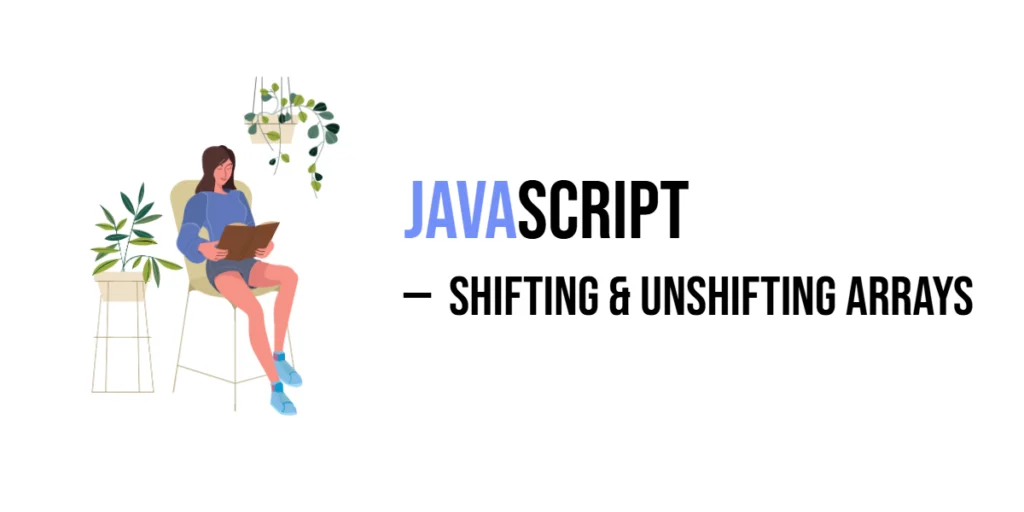In JavaScript, arrays are a fundamental data structure that allow you to store multiple values in a single variable. These values can be accessed by their index, with the first element at index 0. Arrays in JavaScript are quite versatile and can be manipulated using various built-in methods to add, remove, and change elements.
Two common methods for manipulating arrays are shifting and unshifting. Shifting removes an element from the beginning of an array, while unshifting adds one or more elements to the start of the array.
In this article, we’ll focus on how to use the .shift() and .unshift() methods effectively, providing you with clear examples to help you understand how to manipulate arrays in this way.
What Is Shifting in Arrays?
The .shift() method in JavaScript is used to remove the first element from an array. When you use .shift(), it not only removes the first item but also returns that item, allowing you to store or use it later. After calling .shift(), the remaining elements are re-indexed, meaning the second item becomes the first, the third item becomes the second, and so on.
Here’s the basic syntax for using .shift():
array.shift();Let’s look at an example to see how it works:
const fruits = ["apple", "banana", "cherry"];
const removedFruit = fruits.shift();
console.log(removedFruit); // "apple"
console.log(fruits); // ["banana", "cherry"]In this example, we start with an array of fruits. By calling .shift(), we remove the first element, "apple". The value of the removed item is stored in removedFruit, and when we log the updated fruits array, it now contains ["banana", "cherry"].
What Is Unshifting in Arrays?
The .unshift() method in JavaScript is used to add one or more elements to the beginning of an array. Unlike .shift(), which removes elements, .unshift() inserts elements at the start and shifts the existing items to higher indexes. After adding the elements, .unshift() returns the new length of the array.
Here’s the basic syntax for using .unshift():
array.unshift(element1, element2, ...);Let’s look at a simple example to understand how .unshift() works:
const fruits = ["banana", "cherry"];
const newLength = fruits.unshift("apple");
console.log(newLength); // 3
console.log(fruits); // ["apple", "banana", "cherry"]In this example, we start with an array of fruits containing "banana" and "cherry". By calling .unshift("apple"), we add "apple" to the beginning of the array. The method returns the new length of the array, which is 3, and when we log the fruits array, we see that "apple" has been added to the front.
Shifting Multiple Elements
The .shift() method removes only the first element from an array each time it’s called. If you want to remove multiple elements from the start of an array, you can either call .shift() multiple times or use a loop.
Here’s an example where .shift() is called twice to remove two elements from the array:
const numbers = [1, 2, 3, 4];
const first = numbers.shift();
const second = numbers.shift();
console.log(first); // 1
console.log(second); // 2
console.log(numbers); // [3, 4]In this example, we start with an array numbers containing [1, 2, 3, 4]. We call .shift() twice: first to remove 1, and then to remove 2. After these calls, the numbers array is updated to [3, 4]. Each call to .shift() removes only one element from the beginning of the array, and the remaining items are automatically re-indexed.
If you wanted to remove more elements, you could call .shift() as many times as needed, or use a loop to perform the operation.
Unshifting Multiple Elements
The .unshift() method allows you to add multiple elements at the beginning of an array. You can pass as many elements as you need, and they will all be added in the order you provide.
Here’s an example where multiple elements are added to the start of an array:
const numbers = [3, 4];
const newLength = numbers.unshift(1, 2);
console.log(newLength); // 4
console.log(numbers); // [1, 2, 3, 4]In this example, we start with an array numbers containing [3, 4]. By calling .unshift(1, 2), we add 1 and 2 to the beginning of the array. The method returns the new length of the array, which is 4, and when we log the numbers array, we see that it’s now [1, 2, 3, 4].
You can add as many elements as needed, and they will all be inserted at the front of the array in the order they are passed.
Using .shift() and .unshift() with Different Data Types
Both .shift() and .unshift() work with arrays containing various data types, including numbers, strings, objects, and booleans. These methods are flexible and can manipulate any kind of array, regardless of the types of elements within it.
Example with .shift()
In this example, we have an array with mixed data types (a number, a string, and a boolean):
const mixedArray = [1, "hello", true];
mixedArray.shift(); // Removes 1
console.log(mixedArray); // ["hello", true]Here, .shift() removes the first element, which is the number 1, and returns it. The resulting array is ["hello", true].
Example with .unshift()
Now, let’s use .unshift() to add an object to the front of the array:
const mixedArray = ["hello", true];
mixedArray.unshift({ key: "value" });
console.log(mixedArray); // [ { key: 'value' }, 'hello', true ]In this case, .unshift() adds the object { key: "value" } to the front of the array, resulting in [ { key: 'value' }, 'hello', true ].
As you can see, both .shift() and .unshift() can handle arrays that include a mix of primitive values (like numbers and strings) as well as objects, and they function in the same way regardless of the data type.
Chaining .shift() and .unshift()
In JavaScript, you can chain .shift() and .unshift() together to perform multiple array manipulations in one line. This can be useful when you want to modify the array in a sequence of steps.
Example of Chaining .shift() and .unshift()
In the following example, we first remove an item from the start of the array using .shift(), and then add a new item to the front of the array using .unshift():
const numbers = [10, 20, 30];
const firstRemoved = numbers.shift(); // Removes 10
const newLength = numbers.unshift(5); // Adds 5 to the beginning
console.log(firstRemoved); // 10
console.log(numbers); // [5, 20, 30]First, .shift() removes 10 from the array, and firstRemoved stores this value. Next, .unshift(5) adds 5 to the beginning of the modified array. The final array is [5, 20, 30], and the removed item is logged as 10.
Chaining these methods together allows for more concise and readable code when performing multiple operations on an array in sequence.
When to Use .shift() and .unshift()
The .shift() and .unshift() methods are helpful in various situations where you need to manipulate the start of an array. These operations are commonly used in scenarios involving queues or priority lists.
1. Using .shift() in Queues (FIFO)
One common use case for .shift() is when processing items in a queue. A queue operates on the First-In-First-Out (FIFO) principle, meaning the first item that was added is the first to be removed.
For example, in a queue where tasks are processed one by one, you can use .shift() to remove and handle the first task:
const queue = ["task1", "task2", "task3"];
const task = queue.shift(); // Removes "task1"
console.log(task); // "task1"
console.log(queue); // ["task2", "task3"]In this scenario, .shift() is useful for processing items in order, removing each task from the front of the queue as it is completed.
2. Using .unshift() for Priority Lists
When you need to add items to the beginning of an array (e.g., priority tasks or urgent items), .unshift() comes in handy. This allows you to give special importance to tasks or elements that need to be handled first.
For example, in a priority queue, you might add a high-priority task to the start of the list:
const tasks = ["task2", "task3"];
tasks.unshift("high priority task"); // Adds "high priority task" to the start
console.log(tasks); // ["high priority task", "task2", "task3"]In this example, .unshift() ensures that the most important task is processed first by adding it to the front of the list.
Other Possible Scenarios
Real-Time Data Processing: You could use .shift() in real-time applications, like tracking live data or events, where you need to process the earliest data points first.
Managing Undo/Redo Operations: In undo/redo features, .shift() and .unshift() can help manage the history of actions, shifting the last action out of the undo stack and unshifting a new action at the beginning of the redo stack.
Conclusion
In this article, we’ve explored the .shift() and .unshift() methods in JavaScript. Here’s a quick recap of the key points:
.shift()removes the first element from an array and returns it. This is useful when working with queues or when you need to process or remove items from the front of a list..unshift()adds one or more elements to the beginning of an array, making it ideal for situations where you need to prioritize or add elements at the start of a list.
Both methods are simple yet powerful tools for manipulating arrays, particularly when dealing with data that needs to be processed in order or where certain elements must be prioritized.
We encourage you to experiment with these methods in your own projects, as they provide flexibility in managing arrays. By practicing with .shift() and .unshift(), you’ll gain a deeper understanding of how to efficiently manipulate array data and apply these techniques in various real-world scenarios.




